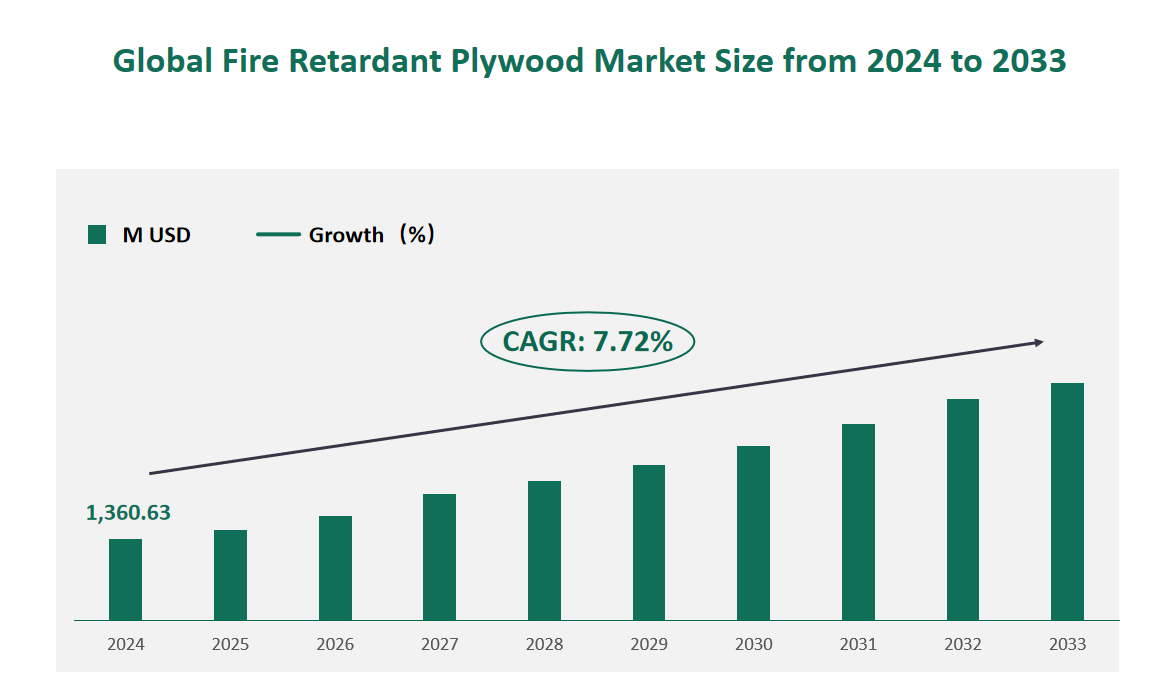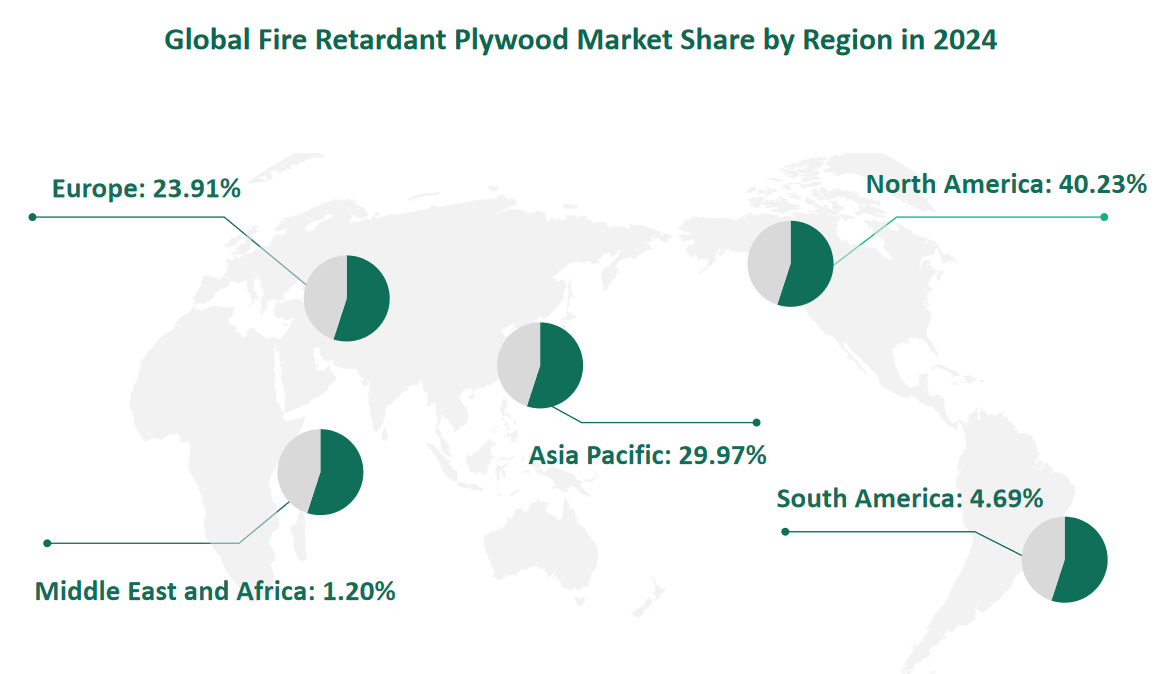1 Global Fire Retardant Plywood Market Size (Value) and CAGR (2024-2033)
In 2024, the global Fire Retardant Plywood market was valued at USD 1,360.63 million, with a CAGR of 7.72% from 2024 to 2033.
Fire Retardant plywood is a three-layer or multi-layer plate-like material that is made by peeling wood pieces into veneer or sliced wood into thin wood. The veneer is flame-retardant treatment and then glued with adhesive to form a three-layer or multi-layer plate material, and fully considered Smoke density and toxic gas indicators for fire hazards.
Figure Global Fire Retardant Plywood Market Size (M USD) and CAGR 2024-2033

2 Fire Retardant Plywood Market Drivers
One of the primary drivers is the development of the construction industry, particularly in the Asia-Pacific region. The booming economy and increased infrastructure development activities in this region have led to a surge in demand for fire retardant plywood.
Another significant driver is the increasing global fire incidents and heightened public safety awareness. The rise in fire incidents has caused significant property losses and casualties, prompting greater attention to fire prevention. Fire retardant plywood, with its ability to inhibit the spread of fire, has become an essential material in construction and manufacturing. Its use is now mandated in many public places, such as theaters, auditoriums, and airports, due to strict fire safety regulations.
Additionally, technological advancements in the production of fire retardant plywood are contributing to its market growth. Companies are continuously innovating to develop new, environmentally friendly, and safer production processes. The development of special functional fire retardant plywood products that meet different functional requirements has become a key innovation point for companies. These advancements not only improve the product’s fire resistance but also enhance its physical and mechanical properties, making it more attractive to end-users.
3 Fire Retardant Plywood Market Challenges
Despite its growth potential, the Fire Retardant Plywood market faces several challenges that could hinder its expansion. One of the most significant challenges is the rising raw material costs. The primary raw material for fire retardant plywood is wood, and its increasing prices have a substantial impact on production costs. Factors such as forest fires, insect infestations, and deforestation have led to a shortage of timber, driving up costs. Additionally, stricter logging regulations and export controls in many countries have further exacerbated the problem.
The fire retardant plywood industry has relatively low technical and entry barriers, leading to a large number of market entrants. This has resulted in a highly fragmented market with low concentration ratios. The excess capacity of low-end products not only affects profit margins but also poses challenges for companies looking to differentiate their products through innovation.
Environmental regulations also pose a significant challenge to the market. As global environmental protection efforts strengthen, many countries have increased restrictions on logging. This has led to a shortage of raw materials and higher costs for manufacturers. Additionally, the inclusion of certain timber resources in protection levels has further complicated the procurement process for companies.
4 Global Fire Retardant Plywood Market Size by Type in 2024
UCFA, which stands for Interior Fire Retardant Plywood, is specifically designed for use in interior applications where the ambient relative humidity is 95% or less. This type of plywood is treated with fire-retardant chemicals to ensure it meets stringent fire safety standards. In 2024, the UCFA segment is expected to account for $759.62 million of the total market value. This type is widely used in buildings, particularly in areas such as kitchens in large restaurants, public theaters, halls, stadiums, and airports, where fire safety is a critical concern.
UCFB, or Exterior Fire Retardant Plywood, is designed for use in exterior applications where the humidity remains below 75%. This type of plywood is treated to withstand harsher environmental conditions and is suitable for situations where the humidity may exceed 95% or where there is potential for water exposure. In 2024, the UCFB segment is projected to reach a market value of $349.08 million. It is commonly used in boat and automotive applications, as well as in outdoor construction projects, due to its enhanced durability and resistance to moisture.
Table Global Fire Retardant Plywood Market Size by Type in 2024
Type | Market Size (M USD) 2024 |
UCFA | 759.62 |
UCFB | 349.08 |
5 Global Fire Retardant Plywood Market Size by Application in 2024
In the Buildings sector, Fire Retardant Plywood is extensively used in public and commercial constructions such as theaters, hospitals, stadiums, and airports. This segment is expected to account for $703.86 million in 2024. The material’s ability to reduce flame spread and smoke density makes it essential for meeting stringent fire safety codes. The growth in this sector is driven by increasing construction activities and heightened awareness of fire safety, particularly in regions with rapid urbanization.
The Boat & Automotive sector is another significant application area, with a projected market value of $277.65 million in 2024. Fire Retardant Plywood is used in the manufacturing of boats and automobiles to enhance passenger safety and meet industry standards. The growth in this segment is driven by advancements in fire retardant technology and increasing demand for fire-safe materials in these industries.
Furniture Manufacturing is a growing application area, with a market value of $345.53 million in 2024. The use of Fire Retardant Plywood in furniture production is driven by consumer awareness of fire safety and regulatory requirements. This material is used in sofas, chairs, and cabinets to reduce fire hazards and improve overall safety.
Table Global Fire Retardant Plywood Market Size by Application in 2024
Application | Market Size (M USD) 2024 |
Buildings | 703.86 |
Boat & Automotive | 277.65 |
Furniture Manufacturing | 345.53 |
Others | 33.59 |
6 Global Fire Retardant Plywood Market Size by Region in 2024
North America is a significant market for Fire Retardant Plywood, driven by stringent building codes and high demand for fire safety in construction and manufacturing. In 2024, the region is expected to account for $547.47 million of the total market value. The market in North America is mature, with a focus on innovation and high-quality products. Increasing construction activities and regulatory requirements continue to drive demand.
Europe is another major market, driven by strict fire safety regulations and high demand for fire retardant materials in building construction and furniture manufacturing. In 2024, the European market is projected to reach $325.36 million. The region is known for its advanced manufacturing capabilities and high-quality products. The European market is characterized by a focus on sustainability and innovation, with increasing construction activities and regulatory requirements as key drivers of growth.
The Asia-Pacific region is experiencing rapid growth in the Fire Retardant Plywood market, driven by booming construction and infrastructure development. In 2024, the region is expected to account for $407.84 million of the total market value. Countries like China and India are major contributors to this growth, with significant opportunities arising from increasing urbanization and infrastructure development. Rising awareness of fire safety is also propelling demand in this region.
Figure Global Fire Retardant Plywood Market Share by Region in 2024

7 Major Players in Global Fire Retardant Plywood Market
7.1 Lonza
Lonza is a leading name in the global wood protection industry, with operations spanning Asia-Pacific, Africa, Europe, North and South America. Established in 1897 and headquartered in Switzerland, Lonza offers a wide range of wood treating chemicals and preservation technologies. The company’s flagship brands include Wolman™, Tanalith™, and Dricon™, which are widely recognized for their effectiveness in wood protection and fire retardancy. Dricon®, for instance, is a Class A fire retardant and preservative designed for interior, weather-protected construction, providing built-in protection from flame spread and smoke development.
In the most recent year, Lonza reported a revenue of $48.20 million from its Fire Retardant Plywood business. The company’s gross margin remained steady at 23.07%.
7.2 Hoover Treated Wood Products, Inc.
Hoover Treated Wood Products, Inc. is a prominent player in the Fire Retardant Plywood market, known for its extensive range of treated wood products. Established in 1955 and headquartered in the USA, Hoover specializes in manufacturing and distributing fire-retardant treated lumber and plywood. The company’s flagship product, Pyro-Guard, is a pressure-impregnated, interior fire-retardant treated lumber and plywood designed for enclosed structural applications. Pyro-Guard is recognized for its superior fire performance, smoke toxicity reduction, and code compliance.
In the most recent year, Hoover Treated Wood Products, Inc. reported a revenue of $35.52 million from its Fire Retardant Plywood business. The company’s gross margin was 21.73%.
7.3 Flameproof Companies
Flameproof Companies is a leading manufacturer of high-performance treated wood products, specializing in fire retardant treated lumber, plywood, OSB, and engineered wood products. Established in 1971 and headquartered in the USA, Flameproof Companies is known for its superior chemistries and code-compliant products. The company’s flagship product, FlameTech™, is a pressure-impregnated fire retardant treated wood that meets stringent international building codes and standards.
In the most recent year, Flameproof Companies reported a revenue of $26.99 million from its Fire Retardant Plywood business. The company’s gross margin was 22.50%.

